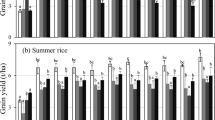Abstract
Silicon-based fertilizers and soil amendments can have direct and indirect positive influences on cultivated plants. The solid forms of Si-based substances, the most widespread in use, are efficient only at high application rates due to their low level of solubility. Several types of Si-based substances such as fumed silica, slags from the iron and steel industry, modified slags, and a Si-rich product were tested using barley and pea as silicon accumulative and non-accumulative plants, respectively, at two application rates. The plants were grown under toxic concentrations of heavy metals in a greenhouse. Si-rich materials high in water-soluble Si had a positive effect at both the low and high application rates, and for both plant species. This type of substance can be regarded as Si fertilizer, demonstrating greater efficiency at a low application rate and lessened efficiency at a high application rate for protection of the cultivated plants against accumulation of the heavy metals.
Similar content being viewed by others
References
Bocharnikova EA, Matichenkov VV (2012) Influence of plant on the silicon cycle in the soil-plant ecosystem. Appl Ecol Environ Res 10(4):547–560
Bocharnikova EA, Pakhnenko EP, Matychenkov VV, Matychenkov IV (2014) The effect of optimization of silicon nutrition on the stability of barley DNA. Moscow University Soil Science Bulletin 69(2):84–87
Dresler S, Wojcik M, Bednarek W, Hanaka A, Tukiendorf A (2015) The effect of silicon on maize growth under cadmium stress. Russ J Plant Physiol 62(1):86–92
Dunkan DB (1955) T tests and intervals for comparisons suggested by the data. Biometrics 11:1–42
Guntzer F, Keller C, Meunier J (2012) Benefits of plant silicon for crops: a review. Agron Sustain Dev 32:201–213
Lamble KJ, Hill SJ (1998) Microwave digestion procedures for environmental matrices. Analyst 123:103R–133R
Liebig J (1840) In: Playfair L (ed) Organic chemistry in its applications to agriculture and physiology. Taylor and Walton, London, p. 195
Ma J, Takahashi E (2002) Soil, fertilizer, and plant silicon research in Japan. Elsevier, The Netherlands, p. 281
Ma J, Yamaji N (2006) Silicon uptake and accumulation in higher plants. Trends Plant Sci 11(8):392–397
Matichenkov VV, Bocharnikova EA (2001) The relationship between Si and soil physical and chemical properties. In: Datnoff LE, Snyder GH, Korndorfer GH (eds) Silicon in studies agriculture. In: plant science, vol 8. Elsevier, Amsterdam, pp. 209–219
Mullin JB, Riley JP (1955) The colorimetric determination of silicate with special reference to sea and natural waters. Analytical Chem Act 12:162–176
Nwugo CC, Huerta AJ (2008) Effect of silicon nutrition on cadmium uptake, growth and photosynthesis of rice plants exposed to low-level cadmium. Plant Soil 311:73–86
Ping L, Xingxiang W, Taolin Z, Dongmei Z, Yuanqiu H (2007) Distribution and accumulation of copper and cadmium in soil-rice system as affected by soil amendments. J Environ Sci 20:449–455
Sebastian D, Rodrigues H, Kinsley C, Korndorfer G, Pereira H, Buck G, Datnoff L, Miranda S, Provance-Bowley M (2013) A 5-day method for determination of soluble silicon concentrations in nonliquid fertilizer materials using a sodium carbonate-ammonium nitrate extractant followed by visible spectroscopy with heteropoly blue analysis: single-laboratory validation. J of AOAC Inter 96(2):251–259
Song A, Li Z, Xue G, Fan F, Liang Y (2009) Silicon-enhanced resistance to cadmium toxicity in Brassica chinesis L. Is attributed to Si-suppressed cadmium uptake and transport and Si-enhanced antioxidant defence capacity. J Hazard Mater 172:74–83
Tripathi DK, Singh VP, Grangwar S, Prasad SM, Maurya JN, Chauhan DK (2014) Role of silicon in enrichment of plant nutrients and protection from biotic and abiotic stresses. In: et AP (ed) Improvement of crops in the era climatic changes, vol 1. Springer Science + Business Media, New York, pp. 39–56
Vaculik M, Lux A, Luxová M, Tanimato E, Lichtscheidl I (2009) Silicon mitigates cadmium inhibitory effects in young maize plants. Environ Exp Bot 67:52–58
Acknowledgments
The study was supported by the International S&T Cooperation Program of China (ISTCP) special project (2015DFR91000) and by the Elkem Silicon Materials.
Author information
Authors and Affiliations
Corresponding author
Additional information
Responsible editor: Elena Maestri
Rights and permissions
About this article
Cite this article
Xiao, W., Yuqiao, L., Qiang, Z. et al. Efficacy of Si fertilization to modulate the heavy metals absorption by barley (Hordeum vulgare L.) and pea (Pisum sativum L.). Environ Sci Pollut Res 23, 20402–20407 (2016). https://doi.org/10.1007/s11356-016-7182-3
Received:
Accepted:
Published:
Issue Date:
DOI: https://doi.org/10.1007/s11356-016-7182-3




